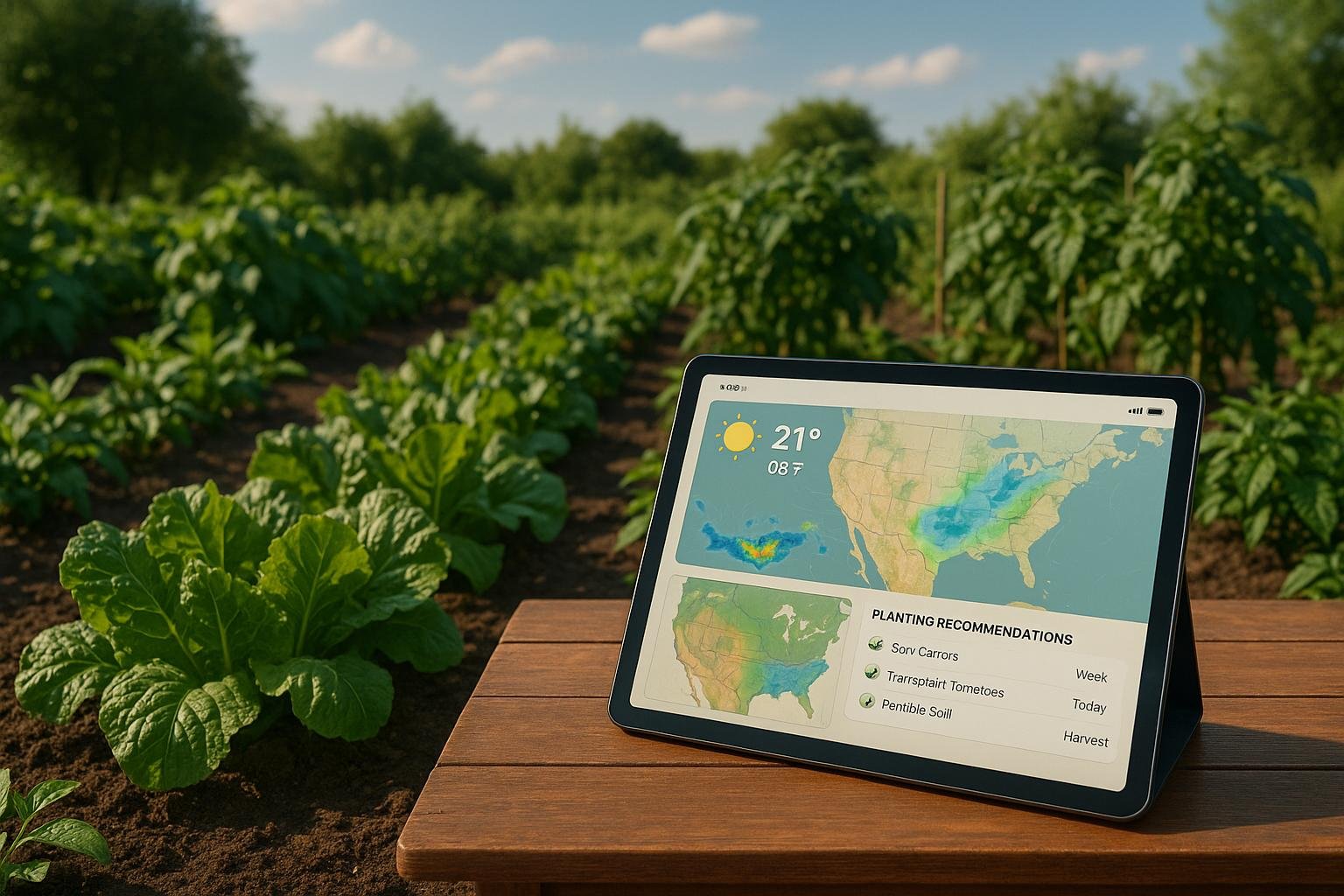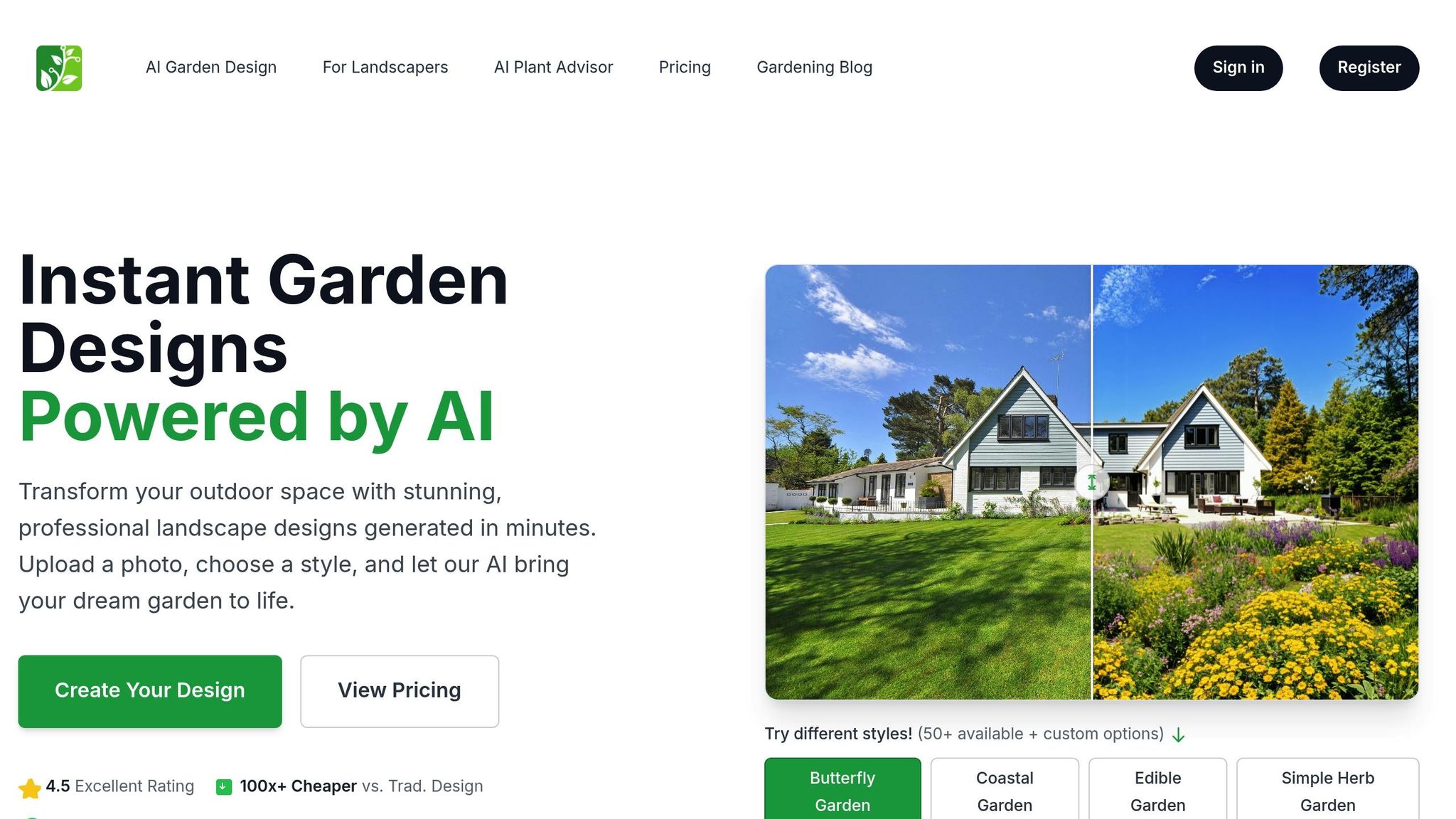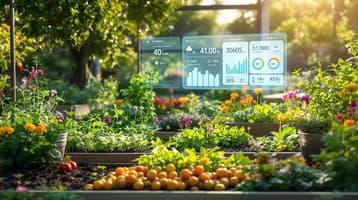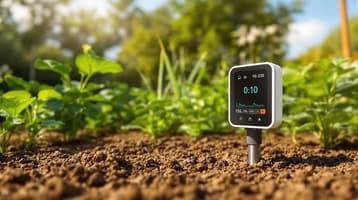How AI Combines Climate Data for Planting

AI is transforming gardening by using climate data to help you make smarter planting decisions. It analyzes weather patterns, soil conditions, and microclimates to provide personalized advice, making gardening easier and more efficient.
Here’s how AI helps:
- Weather Predictions: Identifies the best planting times and warns about frost or drought.
- Soil Monitoring: Tracks moisture, pH, and nutrients for better plant selection and care.
- Resource Management: Reduces water and fertilizer waste with targeted schedules.
- Pest Alerts: Spots potential infestations early using sensors and satellite data.
For example, AI tools like AIGardenPlanner can tell you exactly when to plant tomatoes or how to protect your garden during extreme weather. By combining satellite imagery, IoT sensors, and historical weather data, AI ensures your garden thrives while conserving resources.
Why it matters: AI-powered gardening means healthier plants, less waste, and better resilience to changing climates. Whether you're a novice or an expert, these tools make it simple to grow a successful garden.
Nature Fresh Farms - Maximizing Greenhouse Yield Using AI Powered by Intel


Key Climate Data Sources
AI combines a variety of climate data to provide accurate and actionable planting advice.
Satellite Data and Remote Sensing
Satellites deliver a bird’s-eye view of garden conditions using high-resolution imagery. NASA’s Earth observation satellites, for example, gather key information on soil moisture, temperature, and plant health. These satellites can even detect early signs of plant stress or disease by analyzing subtle changes in vegetation color - often before symptoms are visible to the naked eye.
Take the Landsat-9 satellite, launched in September 2021. Its high-resolution thermal imagery enables AI systems to:
- Monitor soil temperature trends
- Track drought conditions
- Evaluate plant health using vegetation indexes
- Spot potential disease outbreaks early
Local Sensors and IoT Devices
At ground level, smart sensors provide real-time insights tailored to your garden. These devices form a network that continuously delivers data to AI systems for analysis, offering hyper-localized recommendations.
| Sensor Type | Measurements | AI Application |
|---|---|---|
| Soil Probes | Moisture, pH, nutrients | Scheduling irrigation, adjusting fertilization |
| Weather Stations | Temperature, humidity, rainfall | Issuing frost alerts, identifying planting windows |
| Light Sensors | UV levels, shade patterns | Optimizing plant placement |
| Air Quality Monitors | CO2, pollutants | Evaluating growth conditions |
When paired with long-term data, these sensors significantly enhance AI’s ability to predict and adapt to changing conditions.
Weather History Databases
AI also relies on extensive weather records from organizations like NOAA and NASA to analyze long-term patterns. Decades of historical data help AI systems predict future conditions and fine-tune planting strategies. As of February 2025, these systems also incorporate real-time weather forecasts to optimize irrigation and planting schedules.
Historical weather databases uncover trends that might not be immediately obvious. AI uses this information to:
- Estimate frost dates with greater accuracy
- Predict seasonal rainfall variations
- Identify shifts caused by climate change
- Pinpoint the best planting times for specific crops
AI Climate Data Processing Methods
AI takes raw climate data and, through advanced analytical techniques, transforms it into actionable insights for gardeners and farmers. These methods ensure tailored recommendations that are both precise and practical.
Machine Learning for Pattern Detection
Machine learning algorithms are at the heart of AI's ability to analyze climate data. They use various techniques to uncover patterns and make predictions:
| Analysis Type | Purpose | Key Outputs |
|---|---|---|
| Time-Series | Track recurring trends | Temperature changes, rainfall cycles |
| Clustering | Identify similar zones | Microclimate detection |
| Neural Networks | Predict future events | Frost alerts, drought forecasts |
For instance, in February 2025, AI-driven weather models successfully merged satellite imagery with ground station data to deliver highly accurate local forecasts. These advancements allow for more precise climate mapping and planning.
Local Climate Zone Mapping
AI excels at creating detailed microclimate maps by analyzing an array of data sources, including sensors, satellite imagery, topographical details, and historical records. This layered approach reveals small-scale climate variations, such as cold air pockets or areas that retain moisture better. These insights help farmers and gardeners understand their specific growing zones, enabling more informed decisions about planting and crop management.
Weather Pattern Forecasting
By combining historical climate data with real-time updates, AI generates both short-term and seasonal forecasts. These predictions help farmers and gardeners optimize their practices by addressing key factors such as:
- More accurate frost date predictions
- Drought forecasts weeks in advance
- Soil temperature trends for planting
- Seasonal rainfall pattern tracking
A compelling example comes from California, where farmers using AI-powered tools adjusted their planting schedules based on warming trends. This led to a 15% increase in crop yields, showcasing how AI-driven climate analysis directly improves agricultural outcomes.
sbb-itb-4d6a8dd
🚀 Ready to Reinvent Your Garden?
Join thousands of homeowners who have transformed their gardens using our AI design tool. Upload one photo to explore endless possibilities.
Get your AI garden designs →AI Plant Recommendations
AI transforms intricate climate data into practical advice for gardeners and farmers, offering tailored planting guidance. By analyzing a variety of data sources, it helps users make informed decisions to boost their chances of success.
Plant-Climate Matching
AI systems evaluate local environmental conditions to suggest plants best suited to specific regions. This process factors in several key elements:
| Environmental Factor | Data Sources | Influence on Plant Choice |
|---|---|---|
| Temperature Range | Weather stations, satellites | Determines tolerance to heat or cold |
| Rainfall Patterns | Historical records, forecasts | Impacts water needs |
| Soil Composition | Ground sensors, lab tests | Affects nutrient uptake |
| Sun Exposure | Satellite mapping | Guides where plants should be placed |
For instance, if analyzing a garden in Texas, the system might recommend heat-resistant options like lantana or agave, tailored to the area's climate profile. Beyond matching plants to the local environment, AI also refines planting timelines.
Smart Planting Calendar
Using historical weather data and real-time forecasts, AI creates adaptable planting schedules. These calendars help gardeners:
- Avoid frost damage by predicting temperature drops
- Ensure planting aligns with ideal soil temperatures
- Plan harvests ahead of adverse weather
- Organize succession planting for continuous yields
The system continuously updates its recommendations as weather conditions shift. If unusual patterns arise, it adjusts planting times or suggests protective strategies. But its usefulness doesn’t stop there - AI also supports ongoing care.
Live Plant Care Instructions
AI tools provide real-time care advice by monitoring environmental changes. During extreme weather, they recommend specific actions, such as increasing irrigation and shading during heatwaves or improving drainage during heavy rainfall.
Take AIGardenPlanner, for example. This platform combines AI-driven insights with user-uploaded garden photos and local climate data to deliver customized care instructions. It accounts for factors like temperature swings, precipitation forecasts, soil moisture levels, pest risks, and seasonal variations. By doing so, it helps gardeners maintain ideal conditions while conserving resources.
AIGardenPlanner Climate Features

AIGardenPlanner takes advantage of climate data to offer highly accurate, location-specific gardening advice. By tapping into detailed insights, it equips gardeners with tools tailored to their local conditions.
Local Plant Finder
The Local Plant Finder delivers customized plant suggestions by analyzing specific climate factors in your area. Each plant is evaluated for its ability to adapt to local conditions, ensuring you choose species that are most likely to thrive.
| Climate Factor | Data Source | Purpose |
|---|---|---|
| Temperature Range | Weather stations | Evaluates plant temperature tolerance |
| Rainfall Patterns | Historical records | Matches plants to water needs |
| Sun Exposure | Satellite mapping | Assesses light requirements |
| Soil Conditions | Ground sensors | Determines growth compatibility |
For regions prone to drought, the system emphasizes drought-tolerant native plants that require minimal irrigation, making it easier to maintain a sustainable garden.
Climate-Smart Garden Design
This feature helps you plan garden layouts that work in harmony with your local climate. AIGardenPlanner identifies microclimates within your garden, such as areas with more shade, wind exposure, or better moisture retention.
The AI optimizes plant placement by:
- Grouping plants with similar water needs
- Suggesting windbreaks to protect delicate plants
- Recommending permeable surfaces for areas prone to heavy rainfall
- Incorporating water-efficient designs to conserve resources
Water and Care Scheduling
The tool creates dynamic care schedules by factoring in real-time weather data and seasonal changes. Using information from local weather stations and soil sensors, it ensures your garden gets the right care at the right time.
The system adapts recommendations based on:
- Rain forecasts
- Temperature shifts
- Humidity levels
- Seasonal changes
- Severe weather conditions
For example, during heat waves, it might suggest extra watering or temporary shading. Before frost, it advises protective actions to shield plants from the cold.
Conclusion: Smarter Gardening Through AI and Data
AI paired with climate data is reshaping how we plan and care for gardens. By examining environmental patterns and conditions, these tools make it easier to improve plant health and overall garden success.
AI tools now provide gardeners with precise, data-driven advice. For instance, AIGardenPlanner simplifies complex climate data into actionable tips, offering tailored recommendations for planting schedules and care routines.
Gardens that embrace these insights are seeing tangible benefits:
- Lower water consumption
- Improved plant survival rates
- Better resilience to extreme weather
- Seamless seasonal transitions
These results highlight how data-driven gardening can lead to smarter, more efficient practices.
The future of gardening lies in AI-powered climate insights. Tools like AIGardenPlanner bring together satellite imagery, weather forecasts, and local sensor data to help gardeners align their efforts with nature. By combining historical trends with real-time data, this approach creates a unified strategy that helps your garden thrive.
FAQs
How does AI use satellite data and local sensors to give tailored gardening recommendations?
AI pulls together information from various sources, including satellite imagery and local climate sensors, to deliver tailored gardening advice. Satellite data offers a broader view, covering weather patterns, soil conditions, and sunlight exposure. Meanwhile, local sensors gather real-time updates on factors like temperature, humidity, and rainfall specific to your area.
With this data, AI can suggest the ideal planting times, recommend plants suited to your region, and provide care tips customized to your garden's needs. The result? A thriving garden that's perfectly in tune with its environment, making the entire process smoother and more enjoyable.
How does AI help manage gardening resources like water and fertilizer effectively?
AI brings a smarter approach to managing gardening resources by analyzing factors like climate patterns, soil health, and plant requirements. This means gardeners can get precise advice on when and how much to water or fertilize, cutting down on waste and ensuring plants thrive with the nutrients they need, exactly when they need them.
With AI, gardening decisions become more informed. The result? Healthier plants, reduced expenses, and a gardening method that's kinder to the environment. Tools powered by AI can even customize recommendations based on your local weather and the unique conditions of your garden, making resource management not only simpler but also more effective.
How can AI tools like AIGardenPlanner help gardeners adapt to climate changes and grow healthier plants?
AI tools such as AIGardenPlanner take the guesswork out of gardening by examining local climate data, soil conditions, and seasonal patterns. Based on this analysis, they suggest plants that are well-suited to your area, helping gardeners navigate shifting weather conditions and choose hardy plant varieties that can thrive.
Beyond plant recommendations, the platform offers detailed planting guides, pest management tips, and strategies to improve plant health. These resources ensure your garden remains flourishing and productive throughout the year.
🎨 Visualize Your Dream Garden Today!
Transform any outdoor space into a professional landscape design in minutes. Just upload a photo, choose your style, and let our AI do the rest.
Start your garden transformation now →Related posts
Related Articles

Low-Latency IoT Sensors for Pest Monitoring
Explore how IoT pest sensors provide rapid alerts, detailed data, and remote monitoring for effective pest management in your garden.

AI Tools for Adjusting Planting to Rainfall Shifts
Learn how AI tools can optimize your gardening by adjusting planting schedules and layouts based on shifting rainfall patterns.

Best Plant Pairings with AI Suggestions
Explore how AI tools revolutionize gardening by providing personalized plant pairings based on climate, soil, and user preferences.

Ultimate Guide to AI-Powered Soil Monitoring
Learn how AI-powered soil monitoring transforms gardening with real-time insights for healthier soil and more efficient resource use.

5 Solutions for Common Garden Design Challenges
Explore innovative solutions for common garden design challenges, from vertical gardens to AI-driven soil improvements and weather-smart planning.

AI Garden Design for Japanese Zen Gardens
Effortlessly design your own Japanese Zen garden using AI tools that provide tailored suggestions and easy adjustments for any yard.